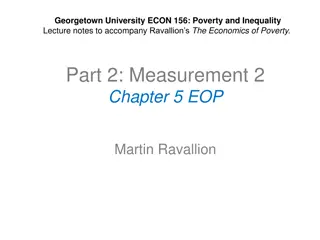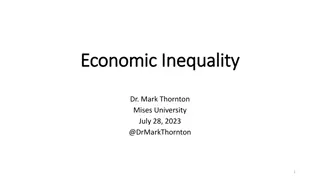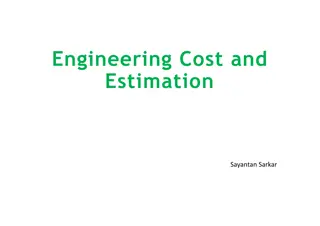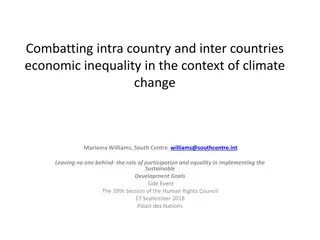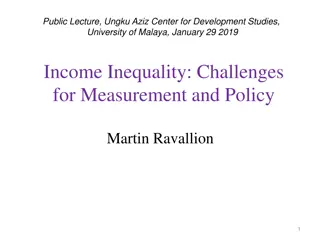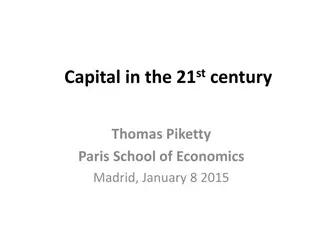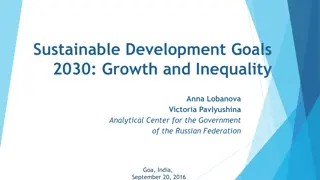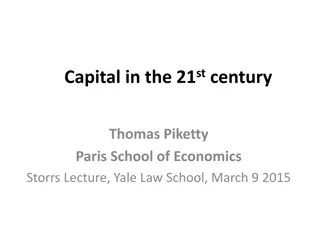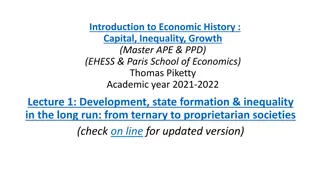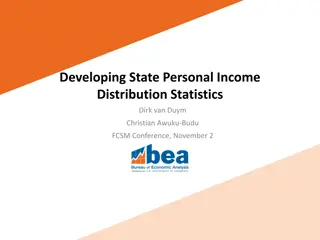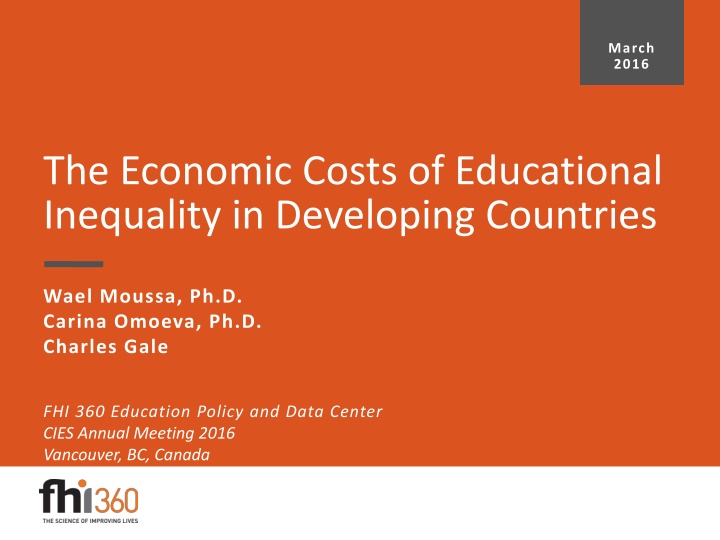
Economic Costs of Educational Inequality in Developing Countries
This research delves into the economic impact of educational disparities in developing countries, revealing significant losses in efficiency across gender and ethnic groups. By reducing educational inequality, economic inequality can be substantially decreased.
Download Presentation

Please find below an Image/Link to download the presentation.
The content on the website is provided AS IS for your information and personal use only. It may not be sold, licensed, or shared on other websites without obtaining consent from the author. If you encounter any issues during the download, it is possible that the publisher has removed the file from their server.
You are allowed to download the files provided on this website for personal or commercial use, subject to the condition that they are used lawfully. All files are the property of their respective owners.
The content on the website is provided AS IS for your information and personal use only. It may not be sold, licensed, or shared on other websites without obtaining consent from the author.
E N D
Presentation Transcript
March 2016 The Economic Costs of Educational Inequality in Developing Countries Wael Moussa, Ph.D. Carina Omoeva, Ph.D. Charles Gale FHI 360 Education Policy and Data Center CIES Annual Meeting 2016 Vancouver, BC, Canada
What is this about? Research Question What is the opportunity cost to an economy associated with pre-existing educational inequalities? What is the number of foregone salaried jobs because of prevailing educational disparities? What are the foregone earnings due to prevailing educational disparities? Which dimensions of group inequality bridge these gaps the most? (gender, ethnic/religious, or both) Simulate the labor market in response to a shift in the educational attainment distribution among groups Examine the impact of reducing educational inequality on economic inequality 2
Preview of Findings We find sizeable losses in efficiency that arise due to inequality in education, across gender groups, ethnic/religious groups, and the interaction Education inequality explains 12% of the gender employment gap and 16% of the gender wage gap Education inequality explains 43% of the salaried employment gap and 49% of the wage gap between ethnic/religious groups Reducing education inequality substantially reduces economic inequality 3
Why is this important? Recent efforts to reduce inequalities in education and otherwise see SDGs 4 and 10 Efforts to expand access to education have successfully increased attainment in the developing world Mean years of schooling have more than doubled since 1965 (Barro & Lee, 2014) However, trends in income and education inequality have only made relatively modest gains since then Since 1985 income and education Gini has stagnated 4
Trends in Income and Education Inequality 5
Contribution to the Literature Our study improves upon the existing literature and contributes in the following ways: We examine distributional changes in education attainment among subpopulations within countries at the micro-level We quantify the opportunity cost of existing inequalities We determine within country changes in economic inequality as a result of reducing educational gaps 6
Empirical Strategy The objective of this research is to construct a counterfactual labor market response to a hypothetical elimination of education disparities between groups We employ a Oaxaca-Blinder decomposition technique Enables us to explain employment and wage gaps between groups due to observed and unobserved factors Technique is prevalent in the Economics and discrimination literature (Oaxaca, 1974; Blinder, 1974) Our focus will be on labor market differences due to gaps in education attainment 7
Procedure 1. Estimate separate labor supply and Mincer wage equations for each group: Y = ED + X + Y = salaried employment indicator, monthly net PPP wage; ED is an array of educational attainment indicators X is an array of observed demographic characteristics 2. Compute the difference in mean Y between the advantaged and disadvantaged group: D = YA YB 3. Decompose the difference into an explained and unexplained component 8
Procedure The decomposition is constructed as follows: D = EDA EDB B+ XA XB B+ EDA A B + XA A B Which reduces to Explained Difference Unexplained Difference D = ED B+ X B+ EDA + XA Due to Education Gap As a result, ED B is the parameter of most interest to our study 9
Data Micro-level data are drawn from the following sources: World Bank Living Standards Measurement Survey (LSMS) World Bank STEP Skills Measurement Survey IPUMS International The analytic data cover 25 countries Most recent year between 2005 and 2013 Restrict the analysis to the population aged 25-59 years Minimize effect of education attendance and retirement decisions 10
Results Gender Employment Inequality We observe between a 10% and 50% total gap in salaried employment Much of the gender employment gap is due to differences in their demographics (household head, marital status, children) and due to unobserved differences (discrimination) Still, reducing the education gap completely is associated with a 13% gain in total employment among females 11
Results Gender Pay Inequality Gender pay gaps vary substantially between countries, even with PPP adjustment Education still explains a relatively modest amount of the gender pay gap Around 40% in Ghana and Malawi Less than 20% in 15 countries Further, reducing the education gap completely results in a 29.6 percent gain in wages 12
Results Gender Pay Inequality We also examine the impact of reducing the gender education gap on the gender employment and pay gaps We find clear indications that larger reductions in gender education gaps are associated with larger reductions in the employment and pay gap For instance, a 50 percent reduction in the gender education gap in Ghana results in about a 30 percent reduction in the gender pay gap 13
Results Ethnic/Religious Employment Inequality The employment gaps between ethnic/religious groups are not as stark as between genders Education explains a more substantial portion of the employment inequality On average, education explains 44% of the total employment gap Reducing the education gap is more effective in Eastern Europe (up to 77%) than in Sub-Saharan Africa (as little as 2%) If the education gaps were eliminated, we estimate that total salaried employment would increase by an average of 32% 14
Results Ethnic/Religious Employment Inequality Different countries exhibit varying levels of pay gaps between ethnic/religious groups e.g. South Africa pay gap between Whites and non-Whites is over $15,000 per year Gaps in education are responsible for up to 88% of the wage disparity (Vietnam) At minimum education explains 13% of the total wage gap (Bosnia) Across all countries, education inequality plays the largest role in income inequality A complete reduction in the educational inequality yields average gains of 93% in annual wages among disadvantaged ethnic/religious groups 15
Results Ethnic/Religious Employment Inequality We examine changes in employment and income Gini coefficients in relation to changes in the group education Gini We find that larger improvements in education inequality are associated with larger gains toward economic equality For instance, lowering education Gini in Malawi by 30 points yields about a 25 point gain in income Gini The gains in economic Gini are greater in terms of annual wages than salaried employment 16
Discussion Results support the hypothesis that reducing education gaps has a positive impact on reducing economic inequality, via the labor market Bridging the education gaps between groups can lead to substantial economic gains, especially to disadvantaged ethnic/religious groups and to a lesser extent females For females, we find that certain observable and unobservable factors, which can be construed as discrimination, explain a substantial portion of the existing inequalities 17
Discussion Eliminating education inequality between genders yields: 13% increase in salaried employment 7 point (mean of 54) decrease in the employment gap 30% increase in annual wages 11 point (mean of 39) decrease in the pay gap Eliminating education inequality between genders yields: 32% increase in salaried employment 5 point (mean of 11) decrease in the employment Gini 93% increase in annual wages 11 point (mean of 18) decrease in the income Gini 18
Discussion The existing gender gap in education is costing the Nigerian economy 538 Dollars (PPP) per working age female Translates to approximately 17 billion Dollars (PPP) in foregone earnings On the lower end, Armenia is losing only about 18 million PPP Dollars The ethnic educational disparities in South Africa are associated with losses of about 5,768 Dollars (PPP) in annual wages per working age non-White individual That is 115 billion Dollars (PPP) in annual earnings due to educational inequality 19
Conclusion We provide evidence that ensuring an equitable distribution of education among a country s disadvantaged groups can yield large economic gains We determine the magnitude (and relative magnitude) of the economic costs of unequal education attainment by gender groups, ethnic/religious groups, and both We identify a cross-country relationship between group education inequality and group economic inequality 20

